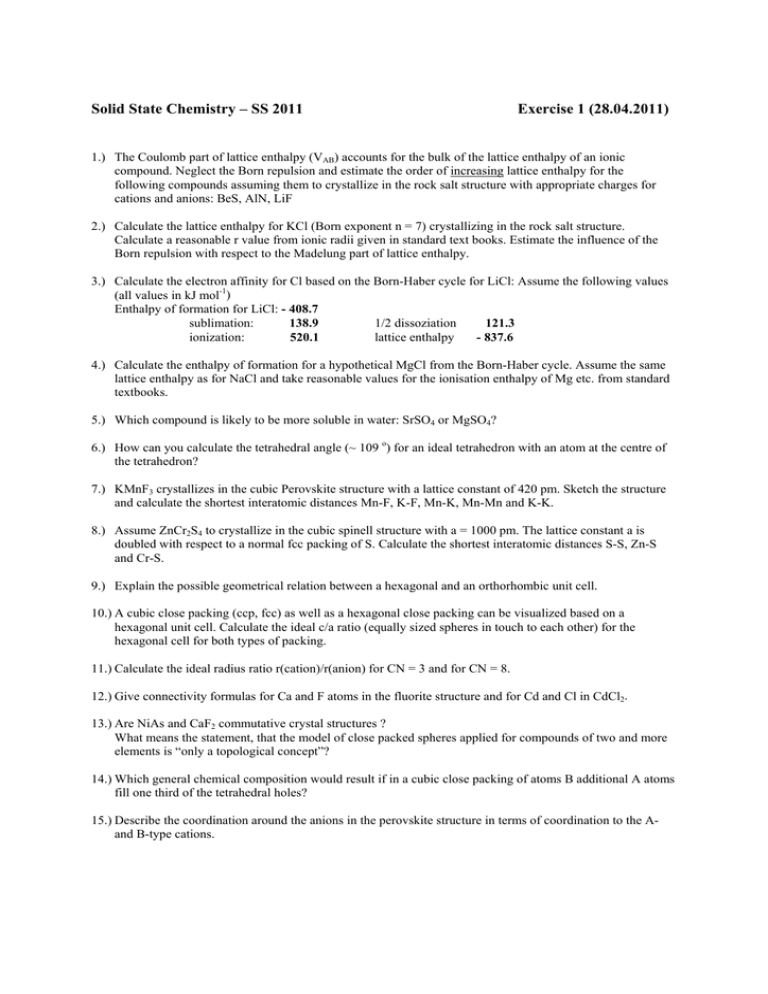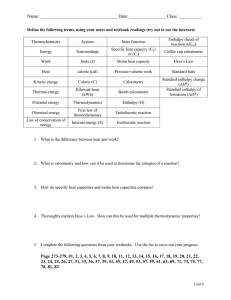Solid State Chemistry – SS 2011 Exercise 1 (28.04.2011)
advertisement

Solid State Chemistry – SS 2011 Exercise 1 (28.04.2011) 1.) The Coulomb part of lattice enthalpy (VAB) accounts for the bulk of the lattice enthalpy of an ionic compound. Neglect the Born repulsion and estimate the order of increasing lattice enthalpy for the following compounds assuming them to crystallize in the rock salt structure with appropriate charges for cations and anions: BeS, AlN, LiF 2.) Calculate the lattice enthalpy for KCl (Born exponent n = 7) crystallizing in the rock salt structure. Calculate a reasonable r value from ionic radii given in standard text books. Estimate the influence of the Born repulsion with respect to the Madelung part of lattice enthalpy. 3.) Calculate the electron affinity for Cl based on the Born-Haber cycle for LiCl: Assume the following values (all values in kJ mol-1) Enthalpy of formation for LiCl: - 408.7 sublimation: 138.9 1/2 dissoziation 121.3 ionization: 520.1 lattice enthalpy - 837.6 4.) Calculate the enthalpy of formation for a hypothetical MgCl from the Born-Haber cycle. Assume the same lattice enthalpy as for NaCl and take reasonable values for the ionisation enthalpy of Mg etc. from standard textbooks. 5.) Which compound is likely to be more soluble in water: SrSO4 or MgSO4? 6.) How can you calculate the tetrahedral angle (~ 109 o) for an ideal tetrahedron with an atom at the centre of the tetrahedron? 7.) KMnF3 crystallizes in the cubic Perovskite structure with a lattice constant of 420 pm. Sketch the structure and calculate the shortest interatomic distances Mn-F, K-F, Mn-K, Mn-Mn and K-K. 8.) Assume ZnCr2S4 to crystallize in the cubic spinell structure with a = 1000 pm. The lattice constant a is doubled with respect to a normal fcc packing of S. Calculate the shortest interatomic distances S-S, Zn-S and Cr-S. 9.) Explain the possible geometrical relation between a hexagonal and an orthorhombic unit cell. 10.) A cubic close packing (ccp, fcc) as well as a hexagonal close packing can be visualized based on a hexagonal unit cell. Calculate the ideal c/a ratio (equally sized spheres in touch to each other) for the hexagonal cell for both types of packing. 11.) Calculate the ideal radius ratio r(cation)/r(anion) for CN = 3 and for CN = 8. 12.) Give connectivity formulas for Ca and F atoms in the fluorite structure and for Cd and Cl in CdCl2. 13.) Are NiAs and CaF2 commutative crystal structures ? What means the statement, that the model of close packed spheres applied for compounds of two and more elements is “only a topological concept”? 14.) Which general chemical composition would result if in a cubic close packing of atoms B additional A atoms fill one third of the tetrahedral holes? 15.) Describe the coordination around the anions in the perovskite structure in terms of coordination to the Aand B-type cations.




